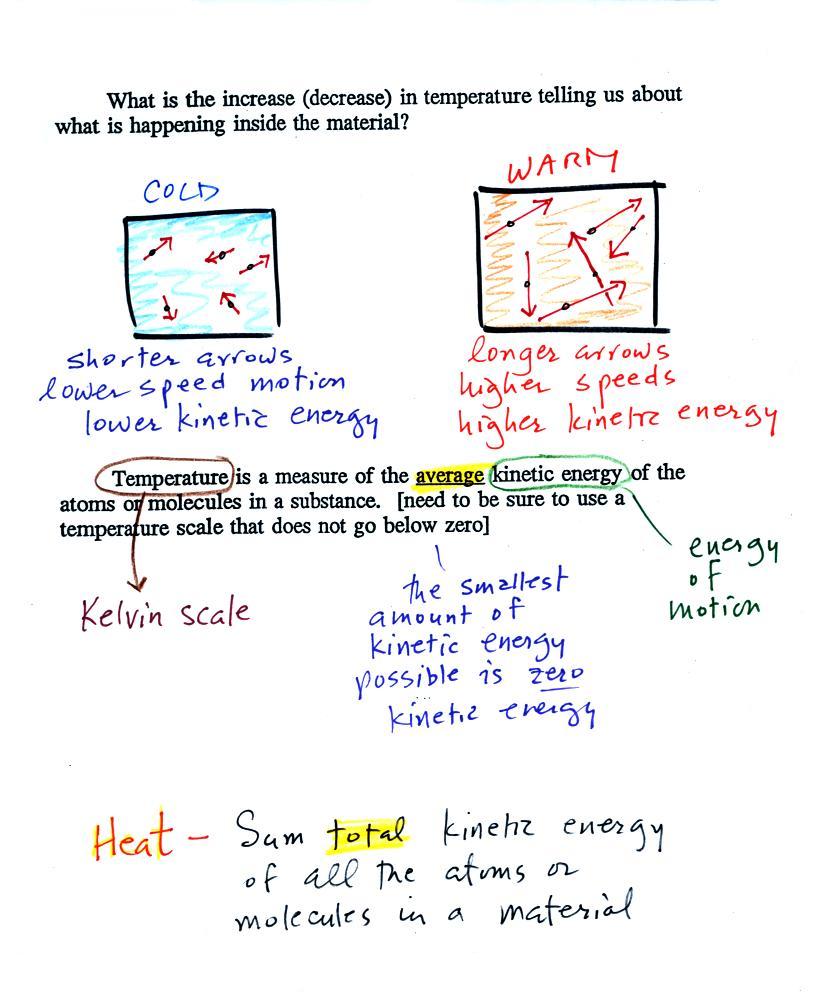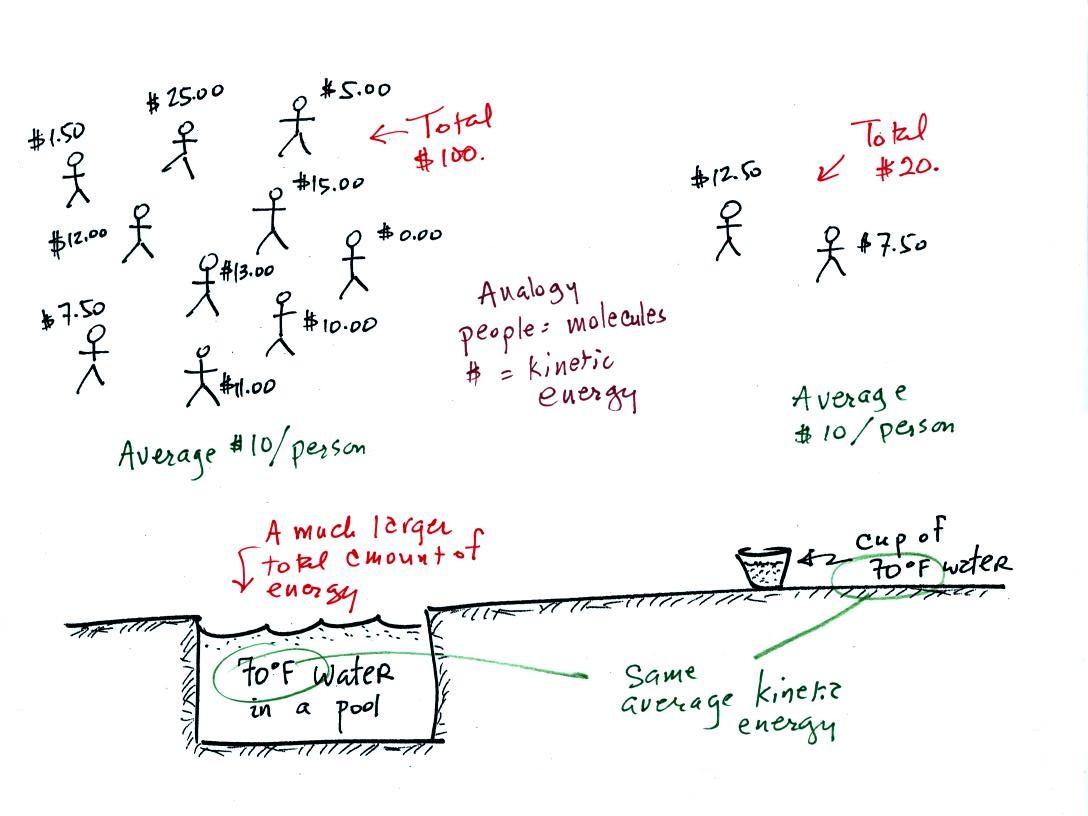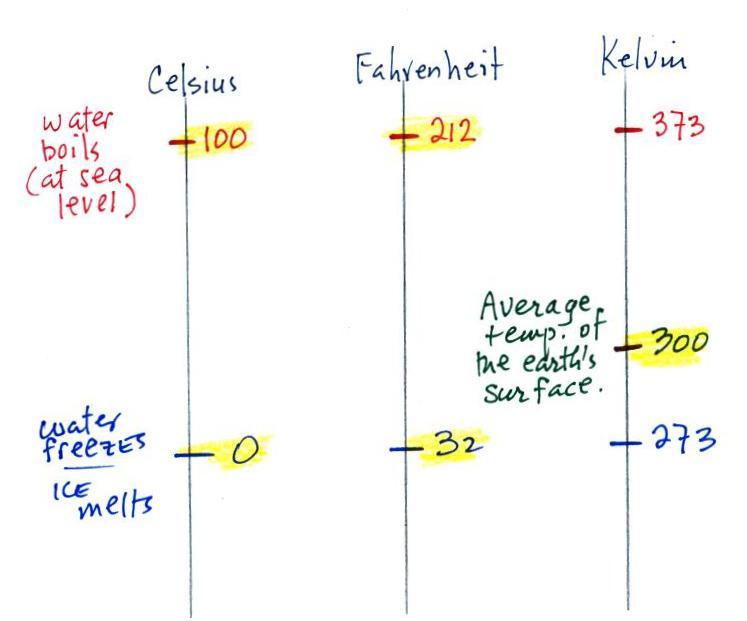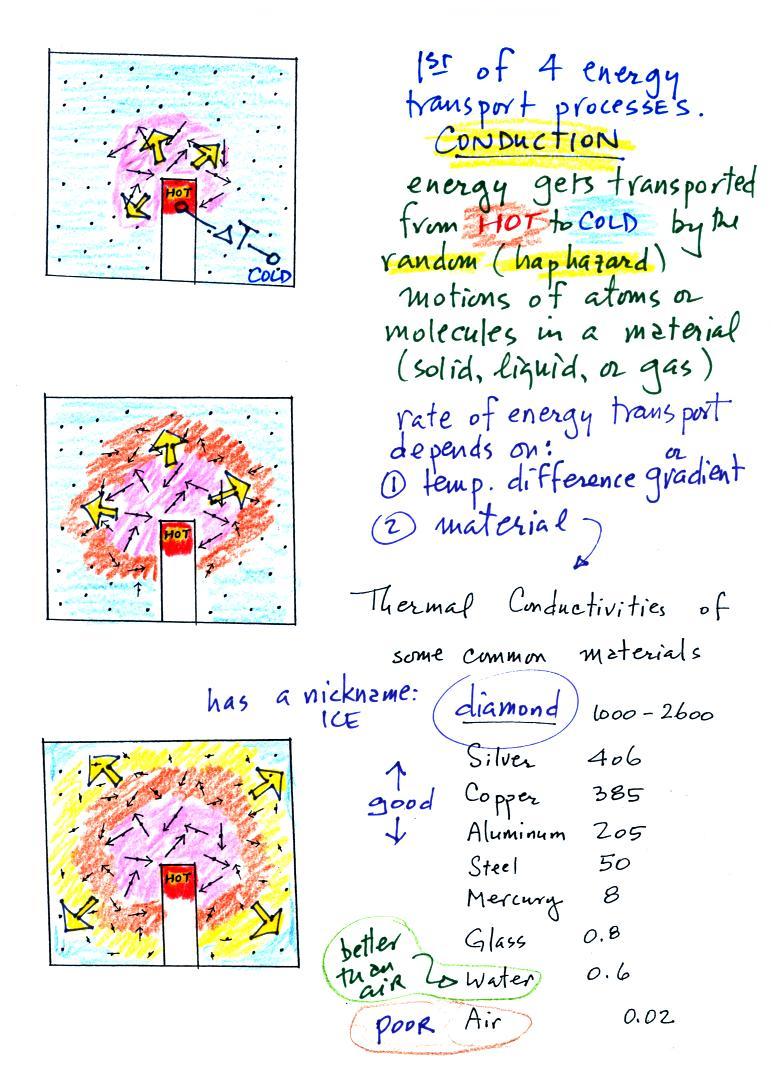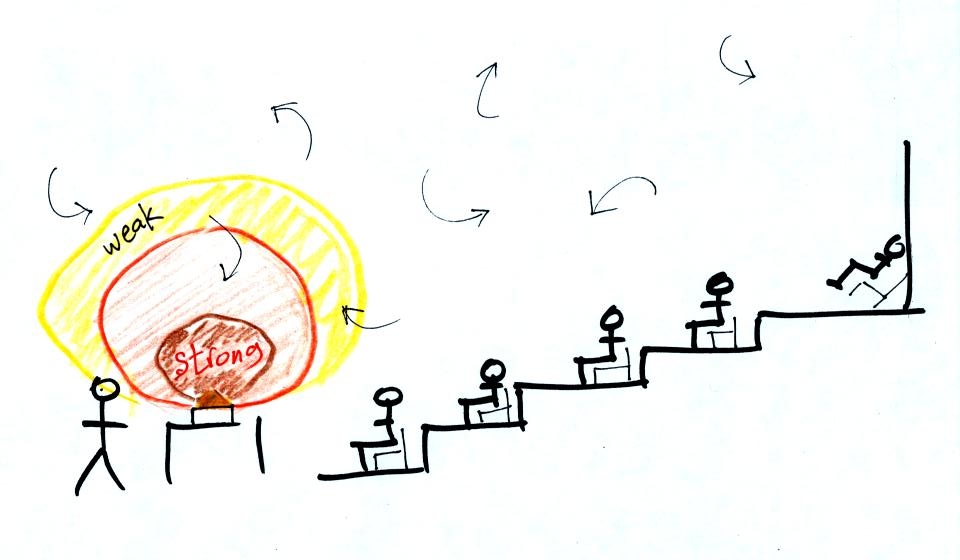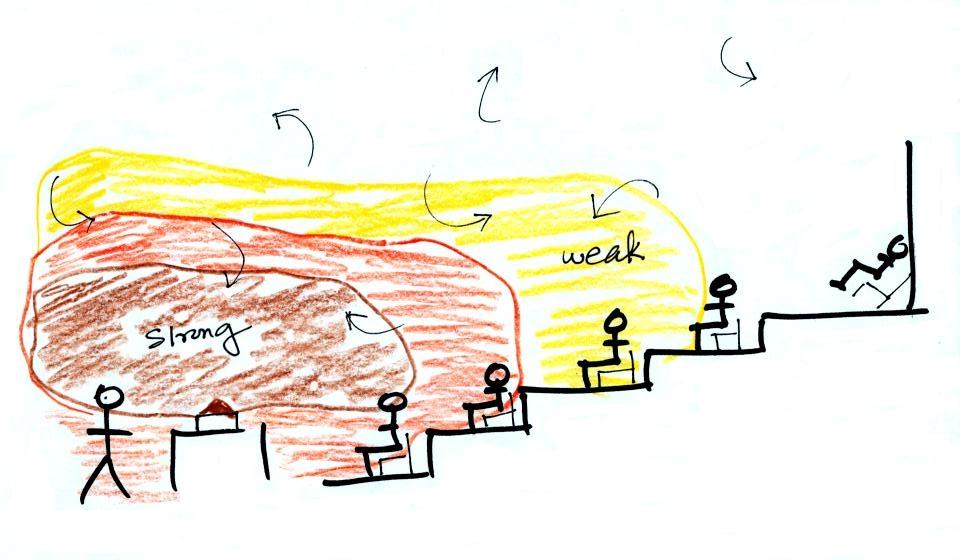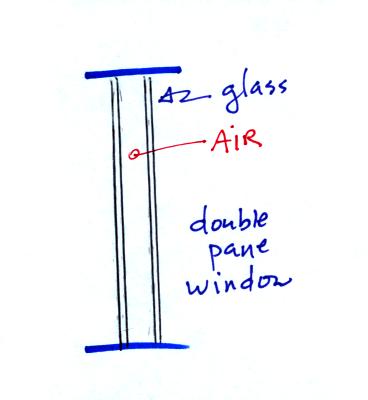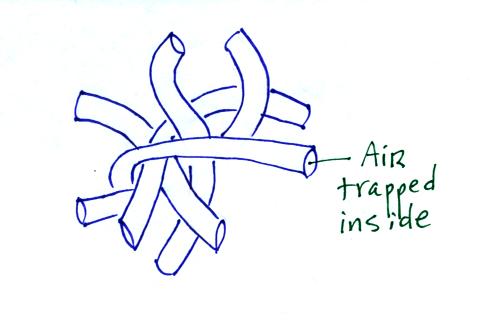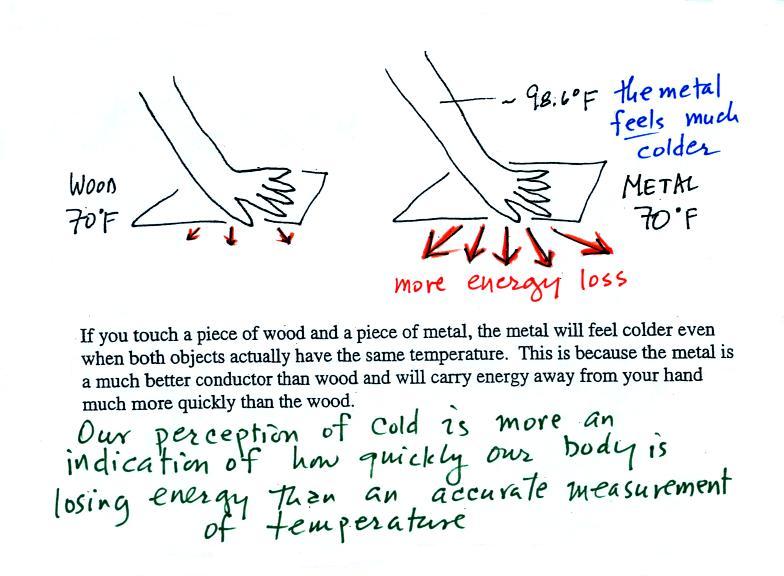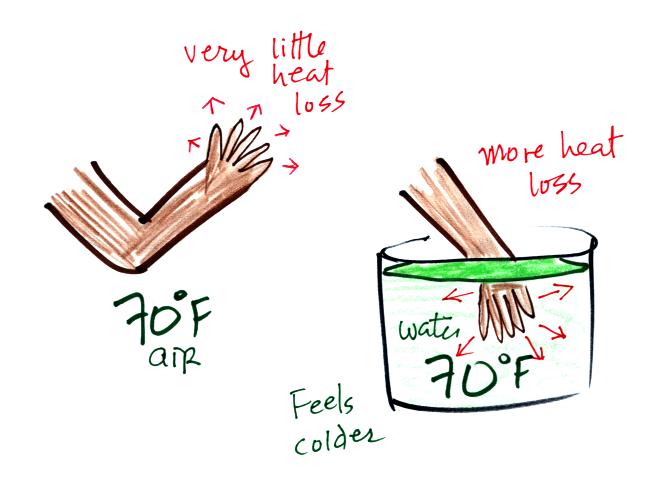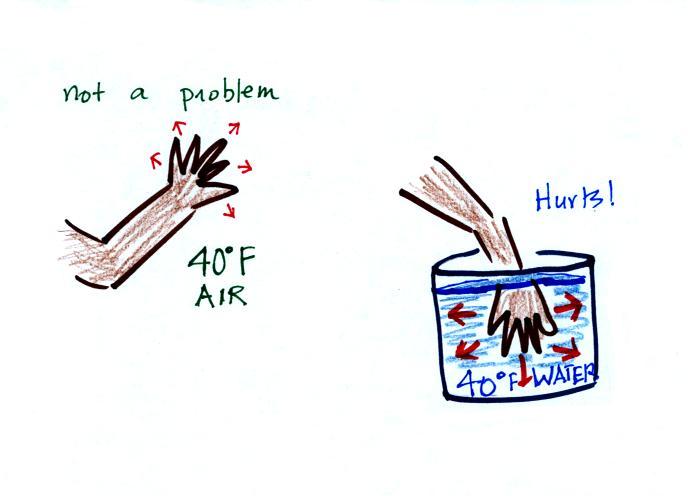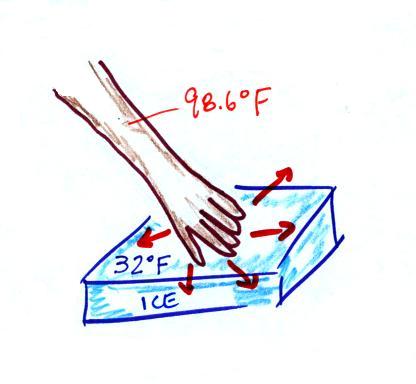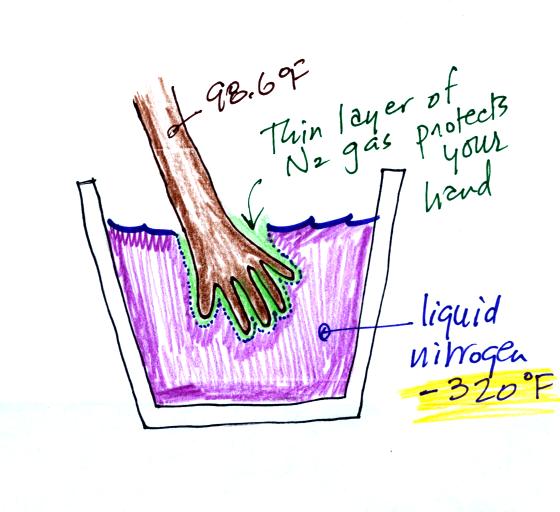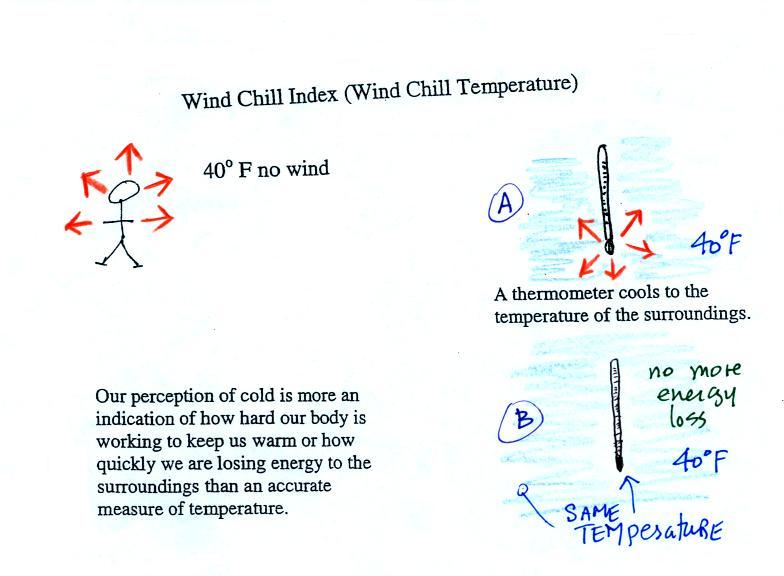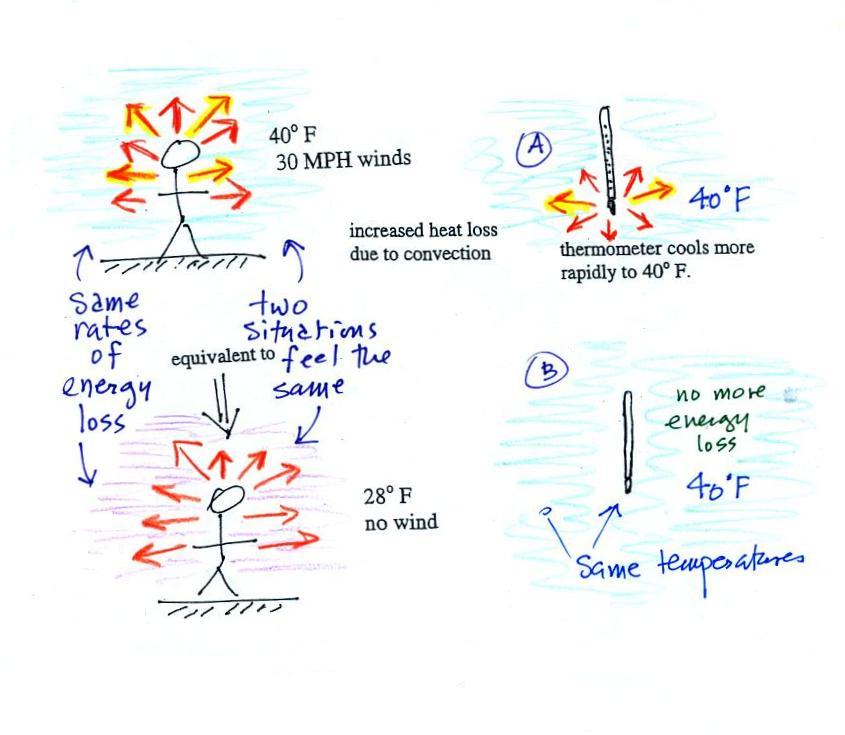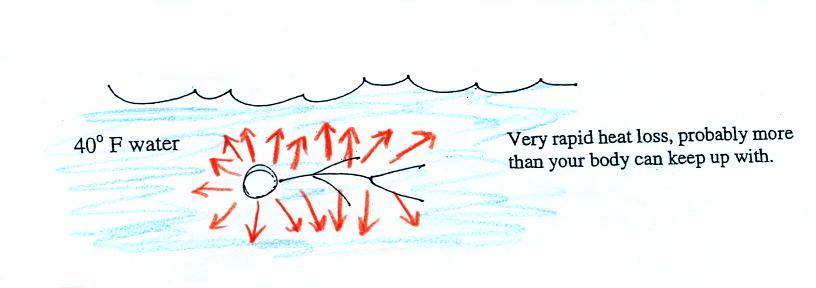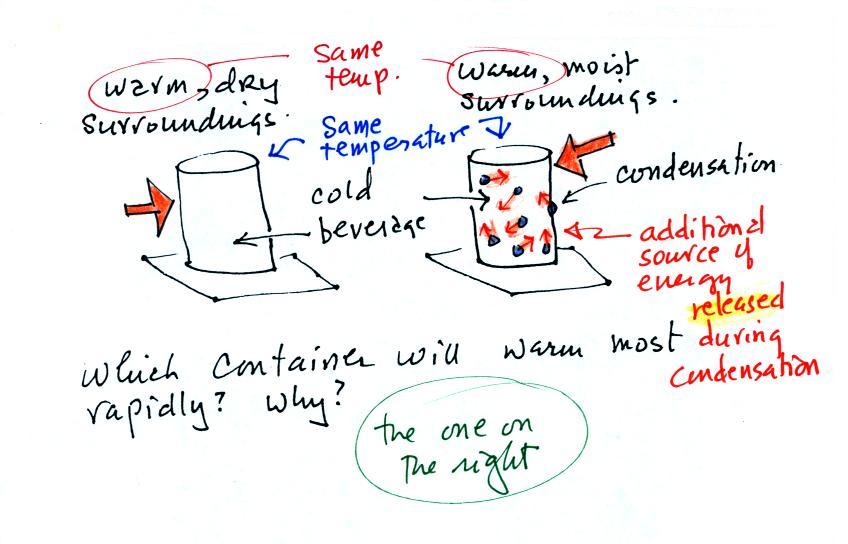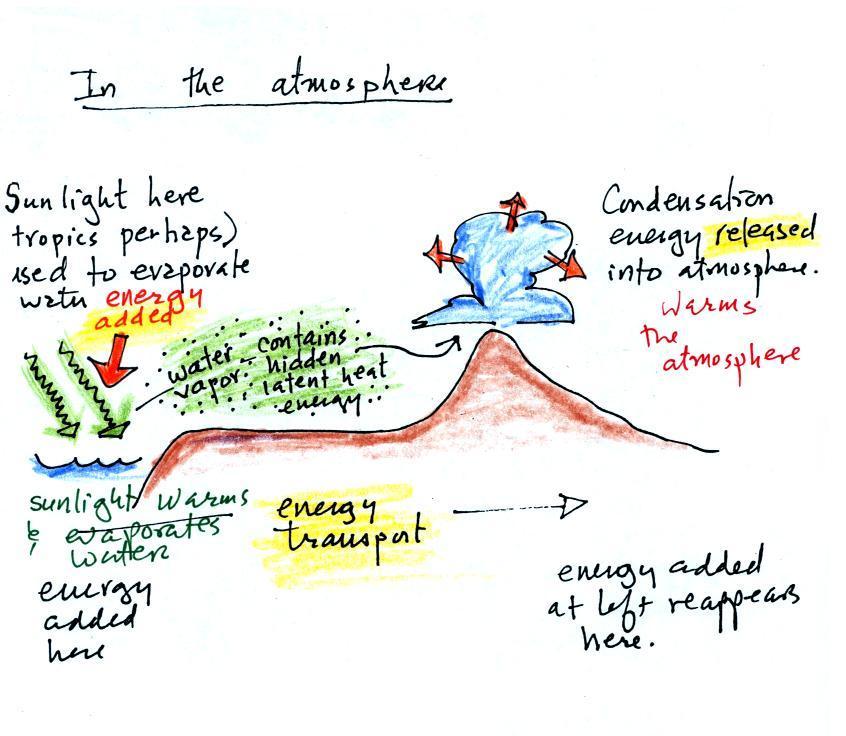When you
add energy to an object and the object warms, what exactly is
happening inside the object?
Temperature provides a measure of the average kinetic of the
atoms or
molecules in a material. The atoms or molecules in a cold
material will be moving more slowly than the atoms or molecules in a
warmer object.
You need to be careful what temperature scale you use when
using
temperature as a measure of average kinetic energy. You must
use the Kelvin temperature scale because it does not go
below zero (0 K is known as absolute zero). The smallest kinetic
energy you can have is zero
kinetic energy. There is no such thing as negative kinetic energy.
You can think of heat as being the total kinetic energy of all
the
molecules or atoms in a material.
The next figure might make the distinction between temperature (average
kinetic energy) and heat (total kinetic energy) clearer.
A cup of water and a pool of water
both have the same
temperature. The average kinetic energy of the water molecules in
the pool and in the cup are the same. There are a lot more
molecules in the pool than in the cup. So if you add together all
the kinetic
energies of all the molecules in the pool you are going to get a much
bigger number than if you sum the kinetic energies of the molecules in
the cup. There is
a lot more stored energy in the pool than in the cup. It would be
a lot harder to cool (or warm) all the water in the pool than it would
be the water in the cup.
In the same way the two groups of people shown have the same
average
amount
of money per person (that's analogous to temperature). The $100
held by the larger group at the
left is
greater than the $20 total possessed by the smaller group of people on
the right (total amount of money is analogous to heat).
Speaking
of temperature scales.
You should remember the
temperatures of the boiling point
and freezing
point of water on the Fahrenheit, Celsius, and perhaps the Kelvin
scales. 300
K is a
good easy-to-remember value for the global annual average surface
temperature of the earth.
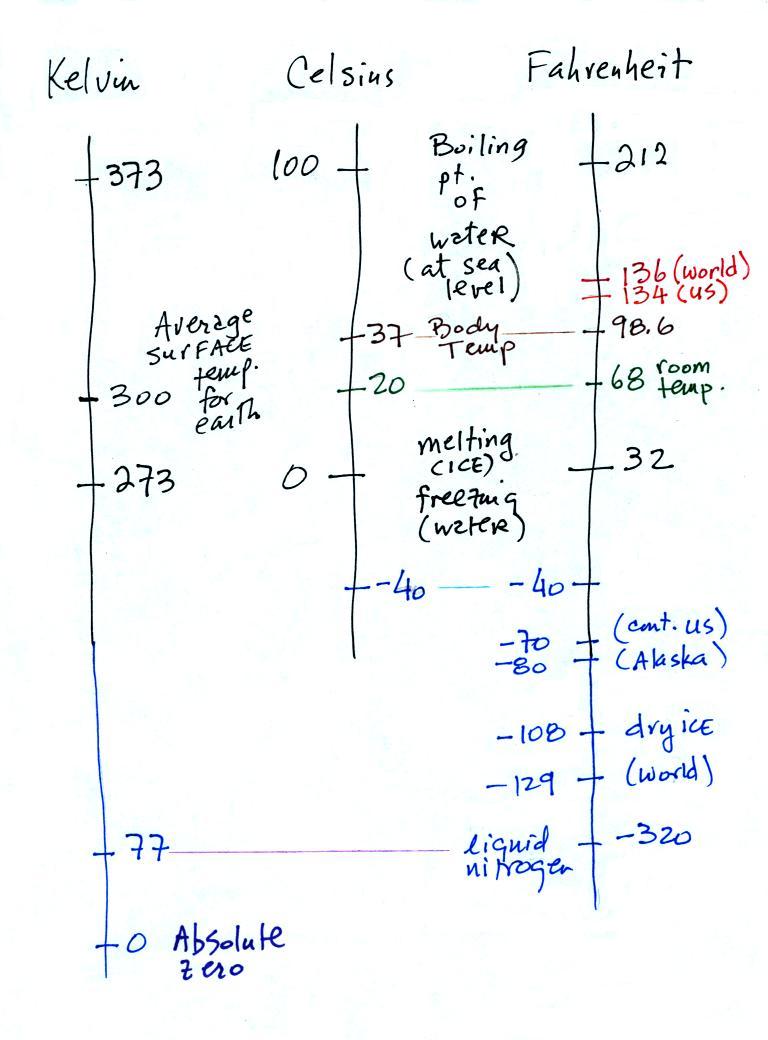
You certainly don't need to try to
remember all these
numbers. The world high temperature record was set in Libya, the
US
record in
Death Valley. The continental US cold temperature record of -70 F
was set in Montana and the -80 F value in Alaska. The world
record -129 F was measured at Vostok station in Antarctica. This
unusually cold reading was the result of three factors: high latitude,
high altitude, and location in the middle of land rather than being
near or
surrounded by ocean. Liquid
nitrogen is very cold but it is still quite a bit warmer than absolute
zero.
Conduction
is the first of four energy transport processes
that we
will cover (the least important transport process in the
atmosphere). The figure below illustrates this process. A
hot object is stuck in the middle of some air.
In the top picture some of the
atoms or molecules near the
hot object have collided with the object and picked up energy from the
object. This is reflected by the increased speed
of motion or increased kinetic energy of these molecules or
atoms (these guys are colored pink).
In the middle picture the
initial bunch of
energetic molecules have
collided with some of their neighbors and shared energy with
them (these are orange). The neighbor molecules have gained
energy though they don't
have as much energy as the molecules next to the hot object.
In
the third picture molecules further out have now (the yellow ones)
gained
some energy. The random motions and collisions
between molecules
is carrying energy from the hot object out into the colder material.
Conduction transports energy from hot to cold. The rate of
energy transport depends first on the material (air in the example
above). Thermal
conductivities of some common materials are listed. Air is a very
poor conductor of energy. Air is generally regarded as an
insulator. Water is a little bit better conductor. Metals
are generally very good conductors (cooking pans are often made of
stainless steel but have aluminum or copper bottoms to evenly spread
out heat when placed on a stove). Diamond has a very high
thermal conductivity. Diamonds are sometimes called "ice."
They feel cold when you touch them. The cold feeling is due to
the fact that they conduct energy very quickly away from your warm
fingers when you touch them.
The rate of energy transport also depends on
temperature
difference. If the object in the picture had been warm rather
than hot, less energy would flow or energy would flow at a slower into
the surrounding material.
Transport of energy by conduction is similar to the
transport of a strong smell throughout a classroom by diffusion.
Small eddies of wind in the classroom blow in random directions and
move smells throughout the room.. Curry powder was used to
demonstrate in the classroom version of this course.
The curry powder was actually
placed on a hot plate. With time and with fresh curry, the smell
should spread
throughout the room.
I didn't check but hopefully even
the students in the back of the room could detect just the faintest
hint of the curry smell.
Because
air has such a low thermal conductivity it is often used as an
insulator. It is important, however, to keep the air trapped in
small pockets or small volumes so that it isn't able to move and
transport energy by convection (we'll look at convection
shortly). Here are some examples of
insulators that use air:
Foam is filled with lots of small air bubbles
Thin insulating layer of air in a double
pane window
Hollow fibers (Hollofil) filled with air used in
sleeping
bags and
winter coats. Goose down works in a similar way.
Convection
was the next energy transport process we had a look at. Rather
than moving about randomly, the atoms or molecules move as a
group. Convection works in liquids and gases but not
solids.
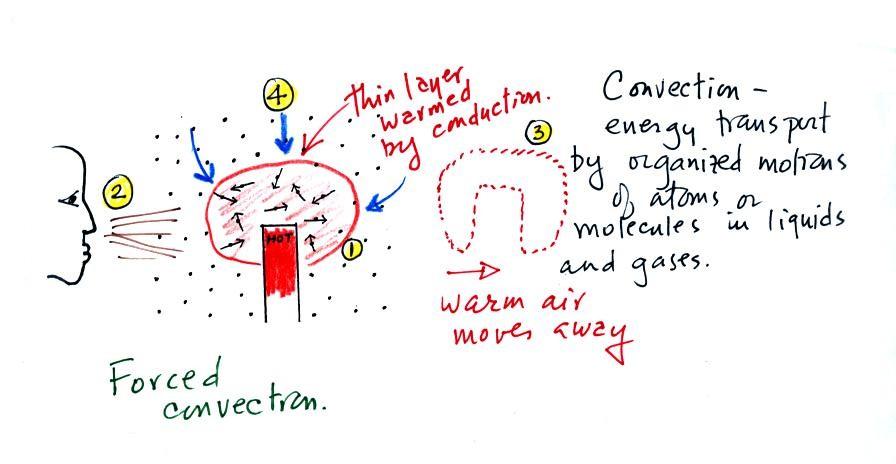
At Point 1 in the picture above a
thin layer of air
surrounding a hot object has
been
heated by conduction. Then at Point 2 a person (yes, that is a drawing
of a
person's head) is blowing the blob of warm air
off to the right. The warm air molecules are moving away at Point
3 from the
hot object together as a group (that's the organized part of the
motion). At Point 4 cooler air moves in and surrounds the hot
object and the whole process can repeat itself.
This is forced
convection. If you have a hot object in your hand you could just
hold onto it and let it cool by conduction. That might take a
while because air is a poor conductor. Or you could blow on the
hot object and force it to cool more quickly. I put a
small fan behind the curry powder to help spread the
smell faster and further out into the classroom.
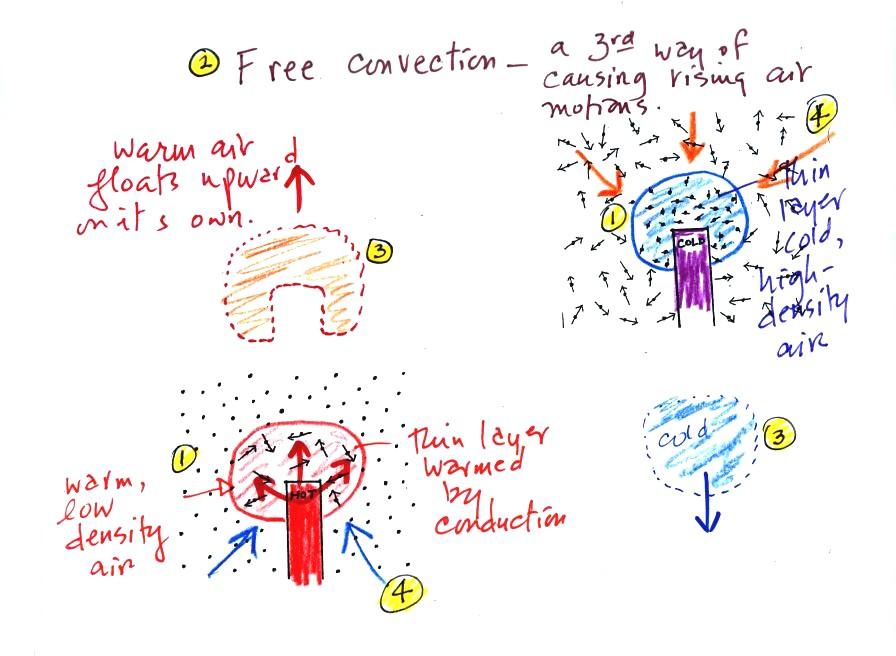
A thin layer of air at Point 1 in
the figure above (lower
left) is
heated by conduction. Then, because hot air is also
low density air, it actually isn't necessary to blow on the hot object,
the
warm air will rise by itself (Point 3). Energy is being
transported away
from the hot object into the cooler surrounding air. This is
called free convection and
represents another way of causing rising air motions in the
atmosphere. Cooler air moves in to take the place of
the rising air at Point 4 and the cycle repeats itself.
The example at upper right is also
free convection. Room temperature air in contact with a cold
object loses energy and becomes cold high density air. The
sinking
air motions that would be found around a cold object have the effect of
transporting energy from the room temperature surroundings to the
colder object.
In both examples of free convection, energy is being transported
from
hot toward cold.
Now some
practical applications of what we have learned about conductive and
convective energy transport. Energy transport really does show up
in a lot more everyday real life situations than you might expect.
Try if you can to find pieces of wood and metal of about the same
size. Touch both objects after you have let them sit at room
temperature for a while. Doesn't the piece of metal feel
noticeably colder than the piece of wood?
There is a temperature difference between
your hand and a 70 F object. Energy will flow from your warm
hand to the colder object. Metals are better conductors than
wood. If you touch a
piece of
70 F metal it will feel much colder than a piece of 70 F wood, even
though they both have the same temperature. Something
that feels cold may not be as
cold as it seems. Our perception of cold is more an
indication of how
quickly our hand is losing energy than a reliable measurement of
temperature. A
piece
of 70 F diamond would feel even colder because it is an even better
conductor
than metal.
Here's a similar situation.
It's pleasant standing outside on a nice day in 70 F air. But if
you jump into 70 F pool water you
will
probably feel cold, at least until you "get used" to the water
temperature (your
body might reduce blood flow to your extremeties and skin to try to
reduce energy loss).
Air is a poor conductor. If you go out in
40 F
weather you will feel cold largely because there is a larger
temperature difference between you and your surroundings (and
temperature difference is one of the factors that affect rate of energy
transport by conduction).
If you stick your hand
into a bucket of 40 F water (and I would suggest you give it a try
sometime), it will feel very cold (your hand will
actually soon begin to hurt). Water is a much better conductor
than air. Energy flows much more rapidly from your hand into the
cold water.
Ice
feels cold even though it is not a particularly good
conductor. This is because of the large temperature difference
between your hand and the water.
What about liquid nitrogen? It has a temperature
of
-320F! You can safely stick your
hand in liquid nitrogen for a "split second." It doesn't
feel particularly cold and doesn't feel wet. Some of the liquid
nitrogen quickly evaporates and surrounds your hand with a layer of
nitrogen
gas. This gas is a poor conductor and insulates your
hand from the cold for a short time.
With this
basic knowledge of conductive and convective energy transport we are in
a perfect position to understand the
concept of wind
chill temperature.
Your body works hard to keep its core temperature around
98.6 F. If you go outside on a 40 F day (calm winds)
you will
feel
cool; your
body is losing energy to the colder surroundings (by conduction
mainly). Your body will be able to keep you warm for a little
while anyway (maybe indefinitely, I don't know). A thermometer
behaves differently, it is supposed to cool to the temperature of the
surroundings. Once it reaches 40 F it won't lose any additional
energy. If your body cools to 40 F you will probably die.
If you go outside on a 40 F day with 30 MPH winds your
body
will lose
energy at a more rapid rate (because convection together with
conduction are transporting energy away from your body). Note the
additional arrows drawn on the figures above indicating the greater
heat loss. This
higher rate of energy loss will make it feel colder
than a 40
F day
with calm winds.
Actually, in terms of the rate at which your
body loses energy, the windy 40 F day would feel the same as a 28
F day without any wind. Your body is losing energy at the same
rate in both
cases. The combination 40 F and 30 MPH winds results in a wind
chill temperature of 28 F.
The thermometer will again cool to the
temperature of its surroundings, it will just cool more quickly on a
windy day. Once the thermometer reaches 40 F there won't be any
additional energy flow. The
thermometer would measure 40 F on both the calm and the windy day.
Standing outside on a 40 F day is not an immediate life
threatening
situation. Falling into 40 F water is.
Energy will be conducted away from your body more quickly
than
your
body can replace it. Your core body temperature will drop and
bring on hypothermia.
Be
sure
not
to
confuse
hypothermia
with
hyperthermia
which
can bring on
heatstroke and which is also a serious outdoors risk in S.
Arizona.
We'll finish this lesson with a short discussion of energy
transport in the form of latent heat, the second most important
energy transport process (second only to electromagnetic
radiation).
If you had an object that you wanted to cool off quickly you could blow
on it. Or you could stick it into some water, that would cool it
off pretty quickly because water will conduct energy more rapidly than
air. With a really hot object immersed in water,
you'd probably hear a brief sizzling sound, the sound
of boiling water. A lot of energy would be taken quickly from the
hot object and used to boil (evaporate) the water.
Latent heat energy transport is sometimes a little hard to visualize
or understand because the energy is "hidden" in water vapor or water.
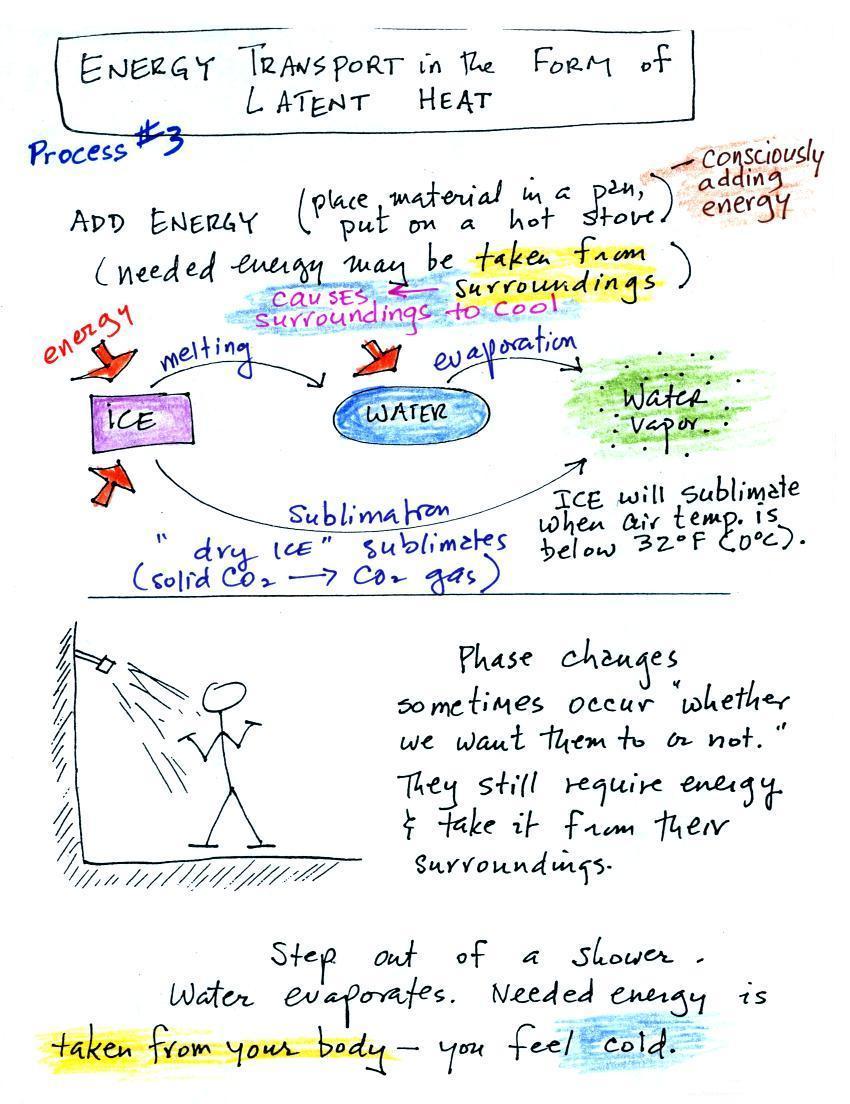
Latent heat energy transport is
associated with changes of
phase (solid to liquid, water to water vapor, that sort of thing) A
solid to liquid phase change is melting, liquid to gas is
evaporation, and sublimation is a solid to gas phase change (dry ice
sublimates when placed in a warm room, it turns directly from solid
carbon dioxide to gaseous carbon dioxide).
In
each case energy must be added to the material changing phase.
You can consciously add or supply the energy (such as when you put
water in a
pan and put the pan on a hot stove) or the phase change can occur
without you playing any role. In that case the needed energy will
be
taken from the surroundings. When you step out of the shower in
the morning, the water takes energy from your body and
evaporates. Because your body is losing energy your body feels
cold.
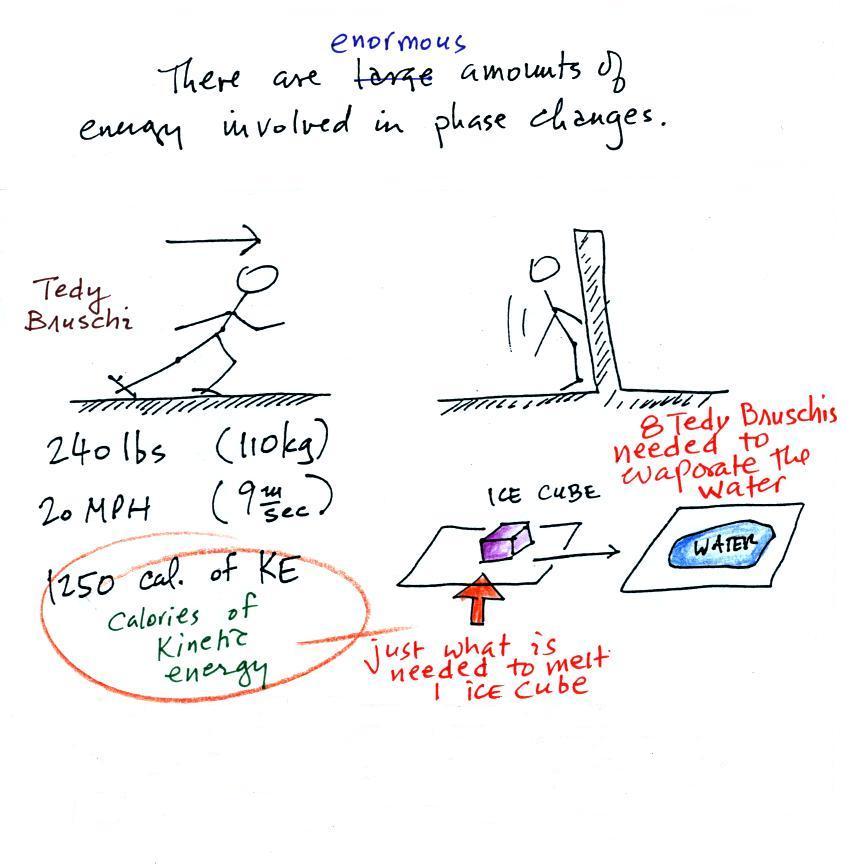
The object of this figure is to give you some appreciation for the
amount of energy involved in phase changes. A 240 pound man or
woman running at 20 MPH has just
enough
kinetic energy (if you could capture it) to
be able to melt an ordinary ice cube. It would take 8 people
running at 20 MPH to
evaporate the resulting water. (Tedy Bruschi
played college football at the University of Arizona)
When you freeze water and make an ice cube energy is released into the
surroundings. You can picture the released energy as being a 240
lb person running at full speed.
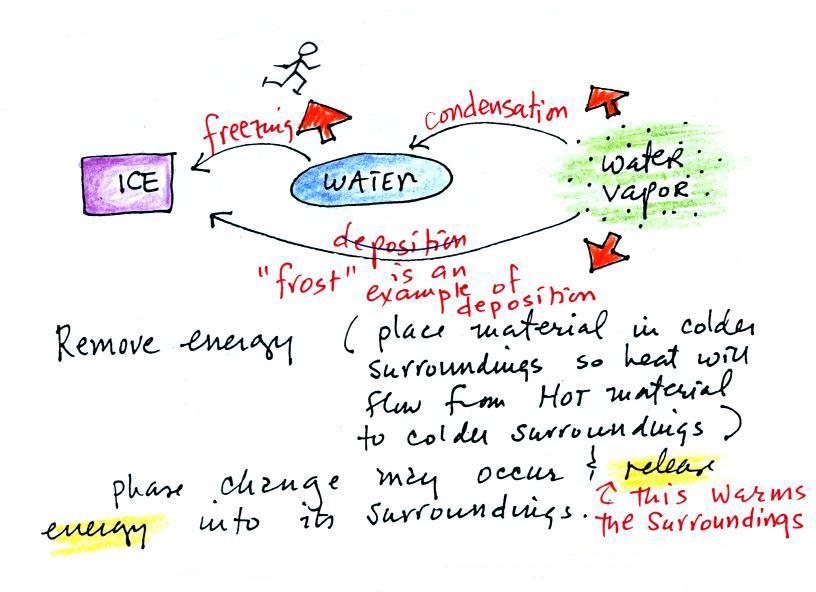
You can consciously remove energy from water vapor to make
it
condense
or from water to cause it to free (you could put water in a
freezer; energy would flow from the relatively warm water to the
colder surroundings - 1 Tedy Bruschi of kinetic energy would come out
of water freezing to make an ice cube). Or if one of these phase
changes occurs energy will be released into the surroundings (causing
the surroundings to warm). Note the orange energy arrows have
turned around and are pointing from the material toward the
surroundings.
A can of cold drink will warm more quickly in warm moist
surroundings
than in warm dry surroundings. Heat will flow from the warm air
into the cold cans in both cases. Condensation of water vapor is
an additional source of energy and will warm that can more
rapidly. The condensation may actually be the dominant process.
You feel cold when you step out of a shower and water on
your body
evaporates. The opposite situation, stepping outdoors on a humid
day
and actually having water vapor condense onto your body (it can happen
to your sunglasses but not to you, your body is too warm). If it
did
happen it would warm you up.
This figure shows how energy can be transported from one
location to another in the form of latent heat. The story starts
at left in the
tropics where there is often an abundance or surplus of sunlight
energy. Some of the incoming
sunlight
evaporates ocean water. The resulting water vapor moves somewhere
else and carries hidden latent heat energy with it. This hidden energy
reappears when something (air running into a mountain and rising,
expanding, and cooling) causes the water vapor to condense. The
condensation releases energy into the surrounding atmosphere.
Energy arriving in sunlight in the tropics has effectively been
transported to the atmosphere in Tucson.
